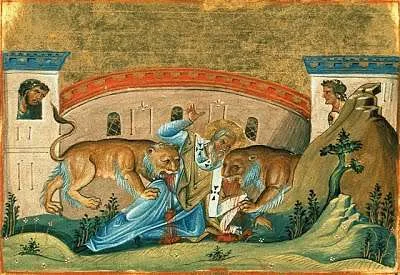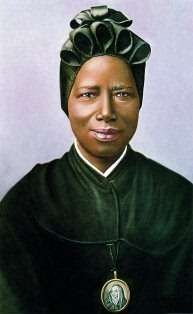Early- to Mid-First Century–c. 107; Patron Saint of the Church in Northern Africa and the Eastern Mediterranean; Invoked against throat diseases; Pre-Congregation canonization
As soon as the Apostles received the gift of the Holy Spirit on Pentecost, they went forth from Jerusalem to preach the Gospel and establish the Church. Saint John the Apostle is said to have preached in Jerusalem and then in Asia Minor. Two of his early disciples were Saint Polycarp, whom Saint John appointed Bishop of Smyrna, and Polycarp’s dear friend, Saint Ignatius, Bishop of Antioch, whom we honor today.
Nothing is known for certain about the early life of Ignatius of Antioch, also known as Ignatius Theophorus (which means “God-Bearer”), but in the centuries that followed his life, much was written about him, most likely based on oral tradition. Some traditions state he was born in Syria and might have been the child whom Jesus placed in the midst of the Twelve, saying, “Whoever receives one child such as this in my name, receives me; and whoever receives me, receives not me but the One who sent me” (Mark 9:37). Other traditions state he was born more than a decade after Jesus’ death and resurrection.
One of the earliest Christian communities to be established by the Apostles was in Antioch, one of the three largest cities in the Roman Empire, along with Alexandria (North Africa) and Rome. Antioch was the capital of the Roman province of Syria and a center for trade, culture, and administration. The Acts of the Apostles states that “it was in Antioch that the disciples were first called Christians” (Acts 11:26). Saints Paul and Barnabas preached there. Tradition holds that Saint Peter was the first Bishop of Antioch before moving to Rome. Around the year A.D. 66, obedient to instructions left behind by Saint Peter, Ignatius became the third Bishop of Antioch and served in that capacity for approximately forty years.
The first major persecution of Christians within the Roman Empire took place under Emperor Nero after the Great Fire in 64. That persecution primarily centered in the city of Rome and is believed to have taken the lives of Saints Peter and Paul, as well as many other Roman martyrs. The second major persecution took place under Roman Emperor Domitian during the years 81–96. Bishop Ignatius was shepherding the Church of Antioch at that time, and it is said that he kept his people safe from persecution through his deep prayer and extreme penances. The third major persecution took place under Emperor Trajan from 98–117. If Christians refused to offer sacrifice to the Roman gods, they were to be executed.
Around the year 107, Trajan was traveling through Antioch and came upon Bishop Ignatius, a man of prominence, known by all as the leader of the Christians. Trajan questioned Ignatius about his faith and ordered him to offer sacrifice to the Roman gods. Ignatius refused and confidently professed his faith in Christ, after which the emperor condemned Ignatius to death. The account of his martyrdom records the emperor’s sentence this way, “We command that Ignatius, who affirms that he carries about within him Him that was crucified, be bound by soldiers, and carried to the great [city] Rome, there to be devoured by the beasts, for the gratification of the people.”
Ignatius was bound in chains and taken more than 1,500 miles by land and sea, from Antioch through modern-day Turkey, across the Aegean Sea, through Greece, across the Ionian Sea to Italy, and by foot to Rome. Along the way, the fourth-century Church historian, Eusebius, tells us, “as he made the journey through Asia under the strictest military surveillance, he fortified the parishes in the various cities where he stopped by oral homilies and exhortations, and warned them above all to be especially on their guard against the heresies that were then beginning to prevail, and exhorted them to hold fast to the tradition of the apostles” (3.36). Of his journey, Ignatius said, “From Syria even unto Rome I fight with wild beasts, by land and by sea, by night and by day, being bound amidst ten leopards? that is, a company of soldiers who only become worse when they are well treated.”
Upon Ignatius’ arrival in Smyrna, the halfway point to Rome, his dear friend, Bishop Polycarp, came out to meet him and kissed the chains that bound him. While in Smyrna, and then at other stops along the way, Bishop Ignatius wrote seven marvelous letters that still exist. They were written to the Churches in Ephesus, Magnesia, Tralles, Rome, Philadelphia, Smyrna, and a personal letter to Bishop Polycarp. Though these letters are not part of the New Testament, in many ways they could be. They mirror the profound faith and personal concern for the newly established Churches that Saint Paul expressed in his New Testament epistles. Pope Benedict XVI called these letters a “precious treasure” and stated, “In reading these texts one feels the freshness of the faith of the generation which had still known the Apostles. In these letters, the ardent love of a saint can also be felt” (General Audience 3/14/2007).
One of the most touching sentiments found in these letters was Ignatius’ burning desire to become “a sacrificial victim for God.” He beautifully expresses his interior longing to become a martyr for Christ and pleads with the Christians in Rome not to stand in the way of his martyrdom but to permit him to be “food for the wild beasts.” His desire was fulfilled when he was mauled to death by lions in the Flavian Amphitheater, Rome.
Ignatius also continually exhorted the Christian communities to reject every heresy attacking the infant Church and to do all they could to preserve the unity they enjoyed in Christ. With the Christian faith being so new, the communities were experiencing growing pains that could tear them apart. Ignatius spoke in a very fatherly way, expressing with heartfelt love that every Christian remains deeply united with each other in Christ. He is thought to be the first to refer to the Church as “Catholic,” meaning universal and full. He offers one of the earliest references to the celebration of the Eucharist in his letter to the Church in Smyrna, stating, “the Eucharist is the flesh of our Savior Jesus Christ, flesh which suffered for our sins and which that Father, in his goodness, raised up again.”
Saint Ignatius of Antioch is one of three Apostolic Fathers, meaning one of three saints who had direct ties to the Apostles and who left behind some writing. Saint Polycarp of Smyrna and Saint Clement of Rome (the fourth pope) are the others. Today, we not only honor Saint Ignatius, we also honor and give thanks to God for all those early evangelists, bishops, martyrs, confessors, and every member of those early Christian communities who helped lay the foundation of the Church.
Reflect, today, upon the burning desire in Saint Ignatius’ heart to die for Christ. Such a desire could only come from a soul that had a profound experience of the transforming love of Christ. Death and suffering became the door through which Saint Ignatius entered the glories of Heaven, and once he knew what awaited him on the other side, he longed for it with his whole being. If you have not arrived at such an interior conviction in your life, seek to discover that which this Apostolic Father discovered.
Source: https://mycatholic.life/saints/saints-of-the-liturgical-year/october-17—st-ignatius-bishop-martyr/








